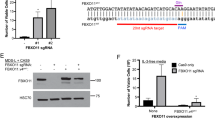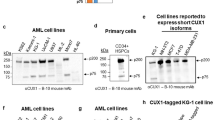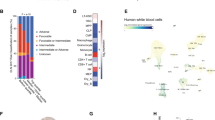Abstract
Human mortalin (HSPA9) was originally identified by its close homology to murine mortalins, which play important roles in cellular senescence. The two murine genes, mot-1 and mot-2, differ in only two amino acid residues, but have opposite functions in cellular immortalization. HSPA9 was recently localized to chromosome 5, band q31, a region that is frequently deleted in myeloid leukemias and myelodysplasia (MDS), making it a candidate tumor suppressor gene, which is consistent with the biological function of its murine homologue. To evaluate mortalin in this capacity, its expression in normal and leukemic cell lines was investigated, and its genomic structure was determined in order to facilitate mutation detection. RT-PCR and Northern blot analysis revealed a broad distribution in normal tissues and in leukemia cell lines, producing a single 2.8 kb transcript. Genomic characterization showed that the gene spans 18 kb, and consisted of 17 exons with boundaries that were almost identical to its murine counterpart. Using intron-based primers to flank each exon, sequence of the complete protein-coding regions was obtained for three AML cell lines, including two lines with chromosome 5 loss (KG-1 and HL-60) and one without (AML-193) compared to normal DNA. No mutations were identified although one conservative nucleotide sequence variant was observed in exon 16. We have shown that mortalin is highly conserved in genomic structure as well as sequence, and the designed primers will be suitable for future studies to detect mutations in clinical samples.
This is a preview of subscription content, access via your institution
Access options
Subscribe to this journal
Receive 12 print issues and online access
$259.00 per year
only $21.58 per issue
Buy this article
- Purchase on Springer Link
- Instant access to full article PDF
Prices may be subject to local taxes which are calculated during checkout



Similar content being viewed by others
References
Wadhwa R, Kaul SC, Mitsui Y, Sugimoto Y . Differential subcellular distribution of mortalin in mortal and immortal mouse and human fibroblasts Exp Cell Res 1993 207: 442–448
Wadhwa R, Mitsui Y, Ide T, Kaul SC . The anti-proliferative aspects of mortalin Int J Oncol 1995 7: 69–74
Wadhwa R, Kaul SC, Sugimoto Y, Mitsui Y . Induction of cellular senescence by transfection of cytosolic mortalin cDNA in NIH 3T3 cells J Biol Chem 1993 268: 22239–22242
Kaul SC, Duncan EL, Englezou A, Takano S, Reddel RR, Mitsui Y, Wadhwa R . Malignant transformation of NIH3T3 cells by over expression of mot-2 protein Oncogene 1998 17: 907–919
Wadhwa R, Akiyama S, Sugihara T, Reddel RR, Mitsui Y, Kaul SC . Genetic differences between the pancytolic and perinuclear forms of murine mortalin Exp Cell Res 1996 226: 381–386
Kaul SC, Wadhwa R, Matsuda Y, Hensler PJ, Pereira-Smith OM, Komatsu Y, Mitsui Y . Mouse and human chromosomal assignments of mortalin, a novel member of the murine 70 family of proteins FEBS Lett 1995 361: 269–272
Horrigan S, Arbieva Z, Xie H, Kravarusic J, Fulton N, Naik H, Lee TT, Westbrook CA . Delineation of a minimal interval and identification of 9 candidates for a tumor suppressor gene in malignant myeloid disorders on 5q31 Blood 2000 95: 2372–2377
Bruno E, Horrigan SK, Van Den Berg D, Rozler E, Fitting PR, Moss ST, Westbrook CA, Hoffman R . The Smad5 gene is involved in the intracellular signaling pathways which mediate the inhibitory effects of transforming growth factor-beta on human hematopoiesis Blood 1998 91: 1917–1923
Horrigan SK, Westbrook CA . Construction and use of YAC contigs in disease regions. In: Boultwood J (ed). Methods in Molecular Biology, Gene Isolation and Mapping Protocols Humana Press: Totowa, NJ 1996; pp 123–136
Michikawa Y, Baba T, Arai Y, Sakakura T, Kusakabe M . Structure and organization of the gene encoding a mouse mitochondrial stress-70 protein FEBS Lett 1993 336: 27–33
Bhattacharyya T, Karnezis AN, Murphy SP, Hoang T, Freeman BC, Phillipa B, Morimoto RI . Cloning and subcellular localization of human mitochondrial hsp70 J Biol Chem 1995 270: 1705–1710
Steube KG, Gignac SM, Hu ZB, Teepe D, Harms D, Kabisch H, Gaedicke G, Hansen-Hagge T, Macleod RAF, Quentmeier H, Drexler HG . In vitro culture studies of childhood myelodysplastic syndrome: establishment of the cell line MUTZ-1 Leuk Lymphoma 1997 25: 345–363
Gallagher R, Collins S, Trujillo J, McCredie K, Ahearn M, Tsai S, Metzgar R, Aulakh G, Ting R, Ruscetti F, Gallo R . Characterization of the continuous, differentiating myeloid cell line (HL-60) from a patient with acute promyelocytic leukemia Blood 1979 54: 713–733
Drexler HG, Minowada J . History and classification of human leukemia–lymphoma cell lines Leuk Lymphoma 1998 31: 305–316
Heim S, Mitelman F . Cancer Cytogenetics Willy-Liss: New York 1995
Nimer SD, Golde DW . The 5q− abnormality Blood 1987 70: 1705–1712
Thirman RS, Larson RA . Therapy-related myeloid leukemia Hematol Oncol Clin North Am 1996 10: 293–320
Larson RA, Le Beau MM, Vardiman JW, Testa JR, Golomb HM, Rowley JD . The predictive value of initial cytogenetic studies in 148 adults with acute nonlymphocytic leukemia: a 12-year study (1970–1982) Cancer Genet Cytogenet 1983 10: 219–236
Schiffer CA, Lee EJ, Tomiyasu T, Wiernik PH, Testa JR . Prognostic impact of cytogenetic abnormalities in patients with de novo acute nonlymphocytic leukemia Blood 1989 73: 263–270
Le Beau MM, Espinosa III R, Neuman WL, Stock W, Roulston D, Larson RA, Reinanen M, Westbrook CA . Cytogenetic and molecular delineation of the smallest commonly deleted region of chromosome 5 in myeloid leukemias Proc Natl Acad Sci USA 1993 90: 5484–5488
Wadhwa R, Takano S, Robert M, Yoshida A, Nomura H, Reddel RR, Mitsui Y, Kaul SC . Inactivation of tumor suppressor p53 by Mot-2, a 70 family member J Biol Chem 1998 273: 29586–29591
Takano S, Washwa R, Yoshii Y, Nose T, Kaul SC, Mitsui Y . Elevated levels of mortalin expression in human brain tumors Exp Cell Res 1997 237: 38–45
Acknowledgements
We would like to thank Dr Ignatius Gomes and Dr Zarema Arbieva for their comments and discussions on the manuscript, Dr Hans G Drexler (DSMZ, Braunschweig, Germany) for kindly providing leukemia cell lines for the study, and Seby Edassery for his assistance in preparation of the figures for the manuscript. This work has been supported by the PHS grants RO1-CA-72593 and PO1-CA-75606.
Author information
Authors and Affiliations
Rights and permissions
About this article
Cite this article
Xie, H., Hu, Z., Chyna, B. et al. Human mortalin (HSPA9): a candidate for the myeloid leukemia tumor suppressor gene on 5q31. Leukemia 14, 2128–2134 (2000). https://doi.org/10.1038/sj.leu.2401935
Received:
Accepted:
Published:
Issue Date:
DOI: https://doi.org/10.1038/sj.leu.2401935
Keywords
This article is cited by
-
Submicroscopic deletion of 5q involving tumor suppressor genes (CTNNA1, HSPA9) and copy neutral loss of heterozygosity associated with TET2 and EZH2 mutations in a case of MDS with normal chromosome and FISH results
Molecular Cytogenetics (2014)
-
Comprehensive array CGH of normal karyotype myelodysplastic syndromes reveals hidden recurrent and individual genomic copy number alterations with prognostic relevance
Leukemia (2011)
-
Cloning, characterization, and functional studies of a human 40-kDa catecholamine-regulated protein: implications in central nervous system disorders
Cell Stress and Chaperones (2009)
-
A novel nuclear protein, 5qNCA (LOC51780) is a candidate for the myeloid leukemia tumor suppressor gene on chromosome 5 band q31
Oncogene (2001)
-
Chromosome and Molecular Abnormalities in Myelodysplastic Syndromes
International Journal of Hematology (2001)



